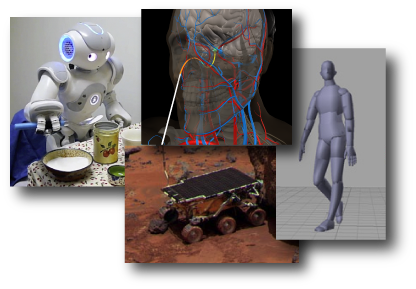

Fall 2011
Time: Tuesdays, Thursdays 2:00pm - 3:15pm
Location: SN 115
Instructor: Prof. Ron Alterovitz
Office hours: Tuesdays 3:15pm - 4:30pm or by appointment, 223 Sitterson Hall
From enabling a robot to accomplish a chore to animating a character in a game, many tasks require planning the motions of real or virtual objects. Motion planning algorithms compute sequences of motions that achieve a particular goal, such as performing surgical tasks using medical robots, enabling self-driving cars, automating tasks in factories and laboratories, simulating character movements in games, animating character motions in movies, and using robots to assist individuals with tasks of daily living. Developing motion planning algorithms is both technically broad and theoretically deep, raising a unique combination of questions in algorithm design, computational geometry, control theory, and robotics.
The course will begin by introducing the fundamentals of motion planning algorithms and then lead to discussions on current research and applications. The topics to be covered, which may be modified based on the interests of enrolled students, include:
Who should attend: Students with interests in motion planning algorithms, graphics, robotics, and computational geometry, as well as application areas such as those listed above. Students from Computer Science as well as other departments are welcome. For students in Computer Science, the course project report could serve as a basis for the MS Program Product requirement and/or the department technical writing requirement.
Credit Hours: Variable (see below).
Grading: For 3 credit hours: 40% course project, 20% presentation, 20% assignments, 20% participation. Each student will select the topic of his/her course project. Each student will also present a topic based on a research paper of his or her choice from the research literature and complete a pair of written/programming assignments. For 1 credit hour: 50% paper presentation, 50% participation.
Prerequisites: Knowledge of undergraduate level calculus, linear algebra, and programming (any language, such as Java, Matlab, C, C++, etc.). Prior coursework in motion planning, robotics, or graphics is not required. Both graduate students and motivated undergraduate students are welcome to enroll.
Textbook: There is no textbook for this course. Course notes, in-class handouts, and links to relevant papers will be provided.